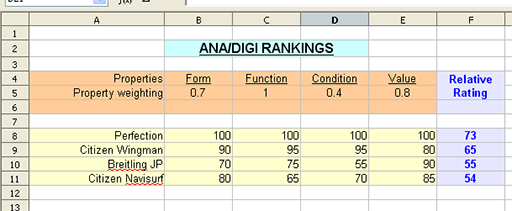When you've collected more than a few watches, there comes a time when you want sell one or two - or you're unsure which ones to keep. You look at one and you want to keep it but it's lume is poor - or this other one keeps perfect time but it's ugly, etc, etc. Then, when you've looked at them all, you have to remember what you thought about each one. There is also a problem for many folks in actually organizing their thinking in such matters especially at my age! However, the world of programming provides a possible solution to organizing your thoughts and spreadsheeting can provide the memory and even rank your collection!
Without going into it too deeply, modern programmimg relies heavily on objects, properties of objects, and values of those properties. If we take "watches" as a class of objects, then we could define an object in that class as an "ana-digi". Now, having chosen analog-digital watches to think about, we would then decide what properties of analog-digital watches are important to a collection. Those properties are your choice, but I would choose something like "form, function, condition & value". After deciding what these named properties represent, you can rate each of your watches by giving a score to each property and then adding them up. The one with the least points would be the first to go if you were culling the collection.
Co-incidentally, it happens that I own several "instances" of ana-digi watches - a Breitling and various Citizens. So I tried the concept out in a spreadsheet. Unfortunately, it didn't really seem to give realistic results. The Breitling came out last, and that's not really what I would do. It came last because of it's ugliness (the form property) and it's a bit beaten up (the condition property). I realized that the concept itself was a little too simple. In the spreadsheet, each property had equal weight - whereas, when considering tool watches such as these, surely function carries more weight than form or condition?
So, back at the spreadsheet, each property was assigned a weighting factor. Now, changing the condition of a watch had less effect than changing the function and, lo, reasonable results were obtained. Here is the sorted result:

"A lot trouble for only three watches", you might say and I agree. But there are folks with twenty or more diver's watches - what if Wifey says "you can't buy any more unless you sell a few?". If you would like to download the spreadsheet to play with, I've posted it here.
Best regards,xpatUSA

No comments:
Post a Comment